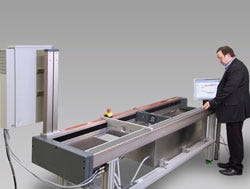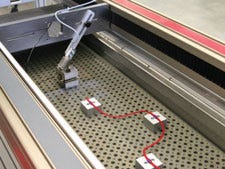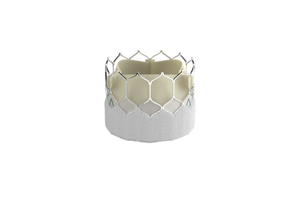Addressing Catheter Testing Challenges
There are many different types of catheters including those used to transport various small instruments or repair devices to the appropriate site in the body. Some catheters have small built-in tools so that a surgeon can repair the patient’s problem without having to perform open heart surgery. Other catheters provide drugs directly to an infected area, while some can deploy a stent that will keep an artery open.
There are many different types of catheters including those used to transport various small instruments or repair devices to a particular site in the body. Some catheters have small built-in tools so that a surgeon can repair a problem in the patient’s body without having to perform open heart surgery. Other catheters deliver drugs directly to an infected area, while some can deploy a stent that will keep an artery open.
For surgeons, challenges associated with such procedures include feeding catheters into femoral arteries, navigating sharp turns, and advancing the device without damaging tissue. Occasionally, angioplasty creates a small tear (dissection) of an internal layer in the coronary artery. If the tear is severe, causing a blockage in blood flow in the artery or loss of blood around the heart, immediate treatment is given. This usually includes a repeat angioplasty and insertion of a stent. Many patients have evidence of a very small amount of heart damage after angioplasty, according to blood testing results. Fewer than 1% of patients, however, have a heart attack severe enough to cause a substantial amount of damage. Manufacturers of catheter systems work closely with surgeons to develop standard and custom catheters, stents, and guidewires to meet these challenges.
Testing for Quality Assurance
|
|---|
The Zwick Z005 TEW horizontal Allround is designed for track tests on catheter systems and guide-wires. |
Catheter manufacturers continually monitor their product by physically testing the complete units, as well as individually testing the component parts. To properly test such devices, catheter manufacturers need to replicate the condition of a patient lying on an operating table and a surgeon inserting a catheter. Meeting such needs requires a horizontal testing machine with a range of special adaptations to facilitate simulated operational procedures being carried out.
"Pull-off" testing is important because joined parts should not fail when the catheter is inside the patient. Stents are tested, both in compression and flexure modes, and the frictional behavior of the complete catheter is measured as it is pushed through a simulated artery known as a “tortuous path.” This test could be performed on a standard vertical testing machine. More realistic results, however, are achieved if the tests are done in a horizontal orientation.
To facilitate this action, test equipment engineers at Zwick GmbH (Ulm, Germany) have developed a system that controls the test machine crosshead and special automated pneumatic grips. The horizontal machine is essentially a test bed that incorporates space above and below the main test axis to accommodate 3-D models and water baths. Even large delivery devices can be mounted and tested throughout their full range of functionality.
In a typical test, the testing machine pushes the catheter into the tortuous path for a designated distance before the pneumatic grip then releases the catheter and the crosshead moves back to the original start point. The pneumatic grips close onto the catheter, moving the crosshead forward once again.
This sequence is repeated until the catheter has been fully inserted into the simulated artery. This test procedure, which is fully automated, can easily accommodate different sizes of tortuous paths and the machine software enables the following results to be calculated:
Track force. Measures the force needed to advance a catheter, interventional device or guide wire through a tortuous path.
Push efficiency. Uses the proximal and distal load cell to measure the amount of force the distal tip of the product sees when a known force is being applied to the product on the proximal end.
Insertion force measurement. Measures the force used to advance through the introducer sheath.
Guidewire movement. Measures the force needed to advance a guide wire though catheter, guide catheter or other interventional device.
Flexibility. Measure of a catheter tips ability to track over a specified bend in a guide wire, such as 90 degrees.
Guidewire and catheter lubricity track measurement. Comparative test using the track test data to determine if coatings affect the force required to advance product through a tortuous path
|
|---|
Mounting plate with threaded holes for individual attachment of specimen holders. |
The results can be calculated with high precision. The extremely stiff load frame with digital control and drive systems ensures that forces measured during the test originate from the sample under test and not from within the machine itself.
The machine control system has such a high degree of accuracy and resolution that it can position the crosshead of the machine to less than 1 µm, and read forces to an accuracy of better than 0.5 % down to values of less than 0.1 mN/0.02 lbf.
The machine software platform can control all of the test parameters including the safety features of the testing machine. At the same time, it can acquire and process the raw test data in real-time and store this data, as individual data points and as calculated result data.
Meeting FDA Requirements
Stringent regulatory environments require the ability to maintain accurate records of the testing procedures and results. Record keeping requirements are described under FDA 21 CFR Part 11.
Part 11 requires drug makers and medical device manufacturers, biotech companies and other FDA-regulated industries to implement controls, including audits, system validations, audit trails, electronic signatures, and documentation for software and systems involved in processing electronic data that are required to be maintained by FDA predicate rules or used to demonstrate compliance to a predicate rule.
Record keeping to meet Part 11 standards can be integrated as an option into software. Medical device companies can take full advantage of this feature and save the costs of third party accreditation.
The software includes the functions; “Electronic Records and Signatures” for complete digital documentation of all safety critical tests. Test results can be automatically stored in the customer’s database through the standard Windows ODBC interface as well as the traditional ASCII format, further improving the data integrity.
Operator Safety
Operator and environment safety concerns are also critical. The testing equipment can be supplied with splash-proof electrical connectors and a supplementary emergency stop button for additional safety.
A moveable touch screen can be fitted to the side of the machine to enable much safer operation so that the operator can start, stop, and monitor the test without having to move to a separate PC. In addition the machine can be supplied with a temperature controlled water-bath to test under varied physiological conditions.
A software plug-in is available that enables a standard video camera to be connected to the system to record the test sequence. The incoming video signal is automatically synchronized with the force and displacement data. It allows a more complete record of the test to be saved or transmitted to interested third parties.
Bob Donohue is the business development manager, medical for Zwick USA (Kennesaw, GA). Erik Berndt is the industry manager, medical for Zwick/Roell AG (Ulm, Germany) and head of the company’s competence center for the medical industry.
About the Author(s)
You May Also Like



.png?width=300&auto=webp&quality=80&disable=upscale)
